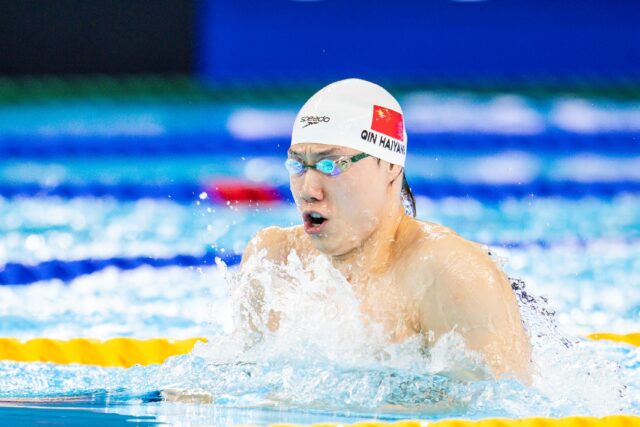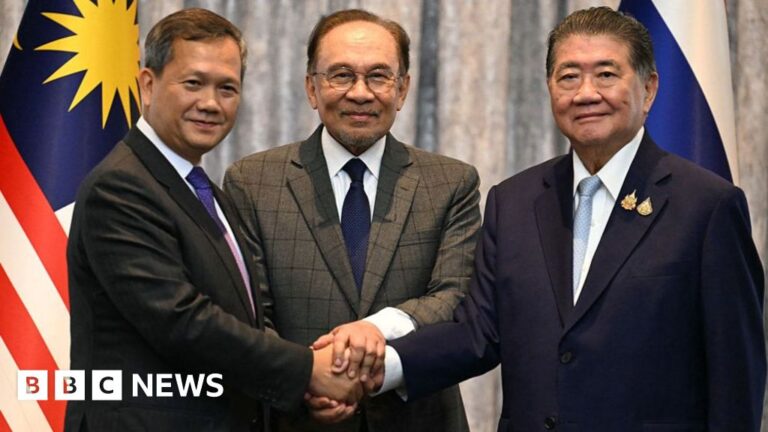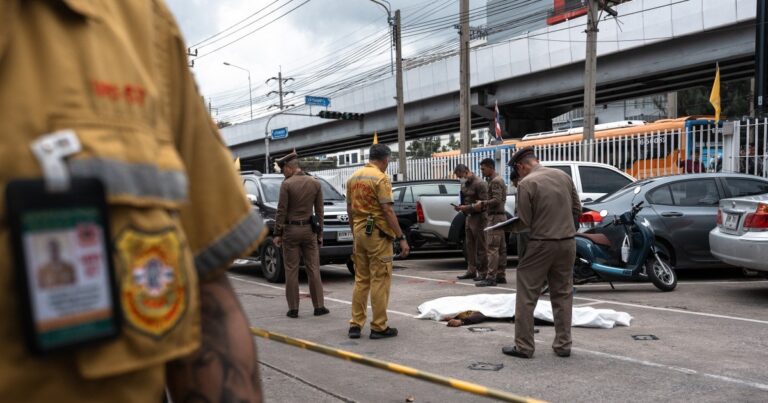By Sophie Kaufman on SwimSwam

2025 World Championships
Happy Monday, everyone! It’s time for the second session of finals at the 2025 World Aquatic Championships in Singapore. There are no relays tonight, but it’s still an action-packed evening with four medal rounds and four semifinals.
Order Of Events:
- Men’s 100 breaststroke final
- Women’s 100 butterfly final
- Men’s 100 backstroke semifinals
- Women’s 100 breaststroke semifinals
- Men’s 50 butterfly final
- Women’s 100 backstroke semifinals
- Men’s 200 freestyle semifinals
- Women’s 200 IM final
Qin Haiyang leads the way into the first final of the evening, the men’s 100 breaststroke. Qin holds about a four-tenth lead over the second seed Nicolo Martinenghi, who was reinstated after originally being disqualified. With Ludovico Viberti holding the third seed, the Italians are looking to put two onto the podium. Germany’s Lucas Matzerath rounded out the swimmers who broke 59 seconds in the semifinal.
Then, the focus shifts to the women’s 100 butterfly final. Gretchen Walsh and Roos Vanotterdijk tied for the top seed overall. Walsh notably scratched the women’s 4×100 freestyle relay final immediately after swimming 56.07 in her semifinal, presumably due to the virus affecting many of the Team USA swimmers. That’s the big question heading into the final, as a healthy Walsh is the heavy favorite in this race.
It was a battle to make the men’s 50 butterfly final, with multiple big names missing out. Maxime Grousset is the top seed after swimming a French record of 22.61 in the semifinals. He’s seeded .11 seconds ahead of short-course world record holder Noe Ponti and former world champion Ben Proud, the latter of whom swam a British record in the event. It’s a European-heavy final as Gui Caribe is the lone finalist from another continent.
The final medal round of the evening is the women’s 200 individual medley. Summer McIntosh breezed through the semifinal about 30 minutes after winning the women’s 400 freestyle. She’s on a quest for five individual gold medals at these World Championships, and she’s put herself in a strong position to grab her second tonight. Alex Walsh and Mio Narita are the second and third seeds behind her, while 12-year-old Yu Zidi qualified 7th overall.
Men’s 100 Breaststroke – Final
Final:
- Qin Haiyang (China) — 58.23
- Nicolo Martinenghi (Italy) — 58.58
- Denis Petrashov (Kyrgyzstan) — 58.88
- Caspar Corbeau (Netherlands) — 59.06
- Ludovico Viberti (Italy) — 59.08
- Lucas Matzerath (Germany) — 59.14
- Josh Matheny (United States) — 59.26
- Danil Semianinov (NAB) — 59.55
DQ: Kirill Prigoda
Qin is back on top. After winning the gold at the 2023 World Championship, Qin had a disappointing performance at the Paris Olympics. But now in his first event in Singapore, he’s already grabbed his first gold medal.
The Paris Olympic champion Martinenghi was out first at the halfway point, turning in 26.90. He was the only swimmer out sub-27 seconds, as Qin turned second in 27.07, less than a tenth ahead of Viberti.
Qin took over on the second 50 meters, coming home in a field-best 31.16. He pulled ahead of Martinenghi and got his hands on the wall first with a 58.23. After being reinstated following a disqualification in the semifinals, Martinenghi grabbed the silver medal in 58.58. Denis Petrashov moved from fourth to third over the final 50 meters, swimming a Kyrgyzstani record to earn bronze. It’s his first time breaking 58 seconds in this race, undercutting the national record of 59.20 that he swam in semifinals to earn his first medal at the World Championship level.
After setting a Russian record in prelims, Kirill Prigoda was disqualified for a downward butterfly kick prior to the finish touch.
WOMEN’S 100 BUTTERFLY – Final
- World Record: 54.60– Gretchen Walsh, United States (2025)
- World Junior Record: 56.33– Mizuki Hirai, Japan (2024)
Championship Record: 55.53 – Sarah Sjostrom, Sweden (2017)- 2023 World Champion – Zhang Yufei, China — 56.12
- 2024 Olympic Champion – Torri Huske, United States — 55.59
Final:
- Gretchen Walsh (United States) — 54.73 *Championship Record*
- Roos Vanotterdijk (Belgium) — 55.84
- Alexandria Perkins (Australia) — 56.33
- Zhang Yufei (China) — 56.47
- Daria Klepikova (NAB) — 56.53
- Angelina Köhler (Germany) — 56.57
- Mizuki Hirai (Japan) — 56.83
- Yu Yiting (China) — 57.36
It seems like Walsh is feeling better.
After getting pulled from the women’s 4×100 freestyle relay in the last finals session, she’s now claimed her first individual long-course world championship title. She did it in championship record fashion too, obliterating the 55.53 Sarah Sjostrom swam at the 2017 World Championships.
“I was aiming for 55, so to go 54 is something I’m really proud of,” Walsh told NBC Sports after the race.
Walsh set the tone early, getting out under her world record pace with a 25.16 split, opening up over a half-second lead on Belgian Roos Vanotterdijk. Walsh also acknowledged in her post-race interview that she’s a swimmer “who flies and dies” but she held on and had the fastest split in the field on the back half of the race, splitting 29.57.
Walsh broke through the 55 second barrier again, swimming a 54.73 to win her title just .13 seconds from the world record she swam in Fort Lauderdale.
Vanotterdijk went three-for-three on personal bests and Belgian records throughout the rounds. She came into the meet with a lifetime best of 57.05 and has lowered her time to 55.84. The silver-medal winning swim makes her the ninth woman to break the 56-second mark.
Australia’s Alexandria Perkins rounded out the podium with a 56.33, holding off a late charge from Zhang Yufei, a two-time Olympic medalist in this event. After a 30.12 closing split, Zhang touched fourth in 56.47.
MEN’S 100 BACKSTROKE – Semifinals
- World Record: 51.60 – Thomas Ceccon, Italy (2022)
- World Junior Record: 52.08 – Miron Lifintsev, Russia (2024)
- Championship Record: 51.60 – Thomas Ceccon, Italy (2022)
- 2023 World Champion: Ryan Murphy, United States – 52.22
- 2024 Olympic Champion: Thomas Ceccon, Italy – 52.00
Top 8 Qualifiers:
- Hubert Kos (Hungary) — 52.21
- Kliment Kolesnikov (NAB) — 52.26
- Pieter Coetze (South Africa) — 52.29
- Thomas Ceccon (Italy) — 52.35
- Oliver Morgan (Great Britain) — 52.41
- Apostolos Christou (Greece) — 52.44
- Yohan Ndoye-Brouard (France) — 52.47
- Miron Lifintsev (NAB) — 52.27
Hubert Kos, the reigning Olympic champion in the 200 backstroke, will swim in lane four tomorrow night for the men’s 100 backstroke final. Kos won the second semifinal in 52.21, clipping Kliment Kolesnikov‘s winning time from the first semifinal by five-hundredths.
The swim is also a Hungarian record for Kos, breaking the standard he set in April at the Hungarian Championships by three-hundredths.
Pieter Coetze continues to swim well after his breakout performance at the World University Games in this event, where he broke through the 52-second mark. Coetze checked in with a 52.29 to move through to the final in third, making it three men to swim 52.2 in the semifinals.
Thomas Ceccon, the Paris Olympic champion, swam in lane one during the second semifinal after an easy morning swim. He picked it up tonight, touching third in his heat with a 52.35 to move through to the final as the fourth seed.
After posting the fastest time in prelims, France’s Yohann Ndoye-Brouard made the final in seventh (52.47). Olympic finalists Apostolos Christou and Oliver Morgan also made it through to the final, as did Miron Lifintsev, who earned double gold in the sprint backstrokes at the 2024 Short Course World Championships.
WOMEN’S 100 BREASTSTROKE – Semifinals
- World Record: 1:04.13 – Lilly King, United States (2017)
- World Junior Record: 1:04.35 – Ruta Meilutyte, Lithuania (2013)
- Championship Record: 1:04.13 – Lilly King, United States (2017)
- 2023 World Champion: Ruta Meilutyte, Lithuania – 1:04.62
- 2024 Olympic Champion: Tatjana Schoenmaker, South Africa – 1:05.28
Top 8 Qualifiers:
- Kate Douglass (United States) — 1:05.49
- Anita Bottazzo (Italy) — 1:05.61
- Tang Qianting (China) — 1:05.87
- Evgeniia Chikunova (NAB) — 1:05.97
- Alina Zmushka (NAA) — 1:06.09
- Satomi Suzuki (Japan) — 1:06.12
- Anna Elendt (Germany) — 1:06.13
- Kotryna Teterevkova (Lithuania) — 1:06.17
Kate Douglass took control of the first semifinal of the women’s 100 breaststroke down the final stretch. The Paris Olympic champion in the 200 breaststroke, Douglass has gotten the chance to show off her sprint breaststroke skills this summer. After winning the 2025 U.S. National Championship, Douglass swam a 1:05.49 here in Singapore, a lifetime best by three-tenths.
That swim held up as the fastest time of the semifinals as the 2024 World Champion Tang Qianting clocked a 1:05.87 to win the second semifinal. She was also the silver medalist in Paris but she’ll head into the final as the third seed. Italy’s Anita Bottazzo swam a lifetime best of her own, 1:05.61, to move into the final as the second seed.
There will be some big names missing from this final. Lilly King missed the final of the 100 breaststroke at her last international competition, finishing ninth in 1:06.26. She missed the final by nine-hundredths. Lithuania has a representative in the final in Kotryna Teterevkova, but Olympic champion Ruta Meilutyte missed out, finishing 13th (1:06.57). Mona McSharry, the top seed coming into semifinals, is also out after touching 11th overall in 1:06.33.
Men’s 50 Butterfly – Final
Final:
- Maxime Grousset (France) — 22.48
- Noe Ponti (Switzerland) — 22.51
- Thomas Ceccon (Italy) — 22.67
- Diogo Ribeiro (Portugal) — 22.77
- Ben Proud (Great Britain) — 22.79
- Nyls Korstanje (Netherlands)/Luca Armbruster (Germany) — 22.84
- (tie)
- Gui Caribe (Brazil) — 22.92
It was a battle between Maxime Grousset and Noe Ponti all the way to the wall for gold. At the touch, Grousset got the better of the short-course world record holder, swimming a 22.48 to out-touch Ponti’s 22.51.
Both move up the all-time performers list. Grousset’s time undercuts the French record of 22.70 he swam in the semifinals by .22 seconds. Meanwhile, Ponti betters the 22.65 he swam last year by nine-hundredths.
The podium was three-for-three on national records. Fresh off the 100 backstroke semifinal, Ceccon–the 2023 world champion in this race–grabbed bronze by lowering his Italian record to 22.67. The swim knocked a hundredth off his lifetime best.
Updated All-Time Top Performer Rankings
- Andrii Govorov, Ukraine – 22.27 (2018)
- Caeleb Dressel, USA – 22.35 (2019)
- Rafa Munoz, Spain – 22.43 (2009)
- Maxime Grousset, France — 22.48 (2025) *NEW*
- Noe Ponti, Switzerland — 22.51 (2025) *NEW*
- Nicholas Santos, Brazil – 22.60 (2023)
- Oleg Kostin, Russia – 22.62 (2023)
- Milorad Cavic, Serbia & Thomas Ceccon, Italy — 22.67 (2009)/(2025) *NEW*
- —
- Ilya Kharun, Canada — 22.68 (2025)
The semifinals featured a barrage of national records and the final did the same. Aside from the medalists, the fourth-place finisher Diogo Ribeiro fired off one of his one, swimming a 22.77. Ribeiro won this event at the 2024 World Championships. Germany’s Luca Armbruster lowered the national record he set in semifinals. He swam 22.84 to tie for sixth with Nyls Korstanje, breaking the 22.91 mark he swam to qualify for the final.
WOMEN’S 100 BACKSTROKE – Semifinals
Top 8 Qualifiers:
- Regan Smith (United States) — 58.21
- Kaylee McKeown (Australia) — 58.44
- Kylie Masse (Canada) — 58.66
- Katharine Berkoff (United States) — 58.79
- Taylor Ruck (Canada) — 59.18
- Peng Xuwei (China) — 59.19
- Mary-Ambre Moluh (France) — 59.35
- SWIM OFF REQUIRED: Pauline Mahieu (France)/Wan Letian (China) — 59.56
The Americans Regan Smith and Katharine Berkoff won their respective semifinals tonight, guaranteeing that both will feature in the final as they aim to back up their medals from the Paris Games.
Berkoff won the first semifinal in 58.79, with Taylor Ruck taking second in 59.18. That put her in a solid position ahead of the second semifinal, which featured the likes of Smith, Kaylee McKeown, and Kylie Masse.
Smith checked in with a 58.21 for the win in the second semifinal, cruising in .23 seconds ahead of McKeown, the two-time defending Olympic champion, and .45 seconds ahead of the veteran Masse. McKeown’s 58.44 and Masse’s 58.66 mean they will be on either side of Smith in tomorrow’s final, with Berkoff qualifying fourth.
The final will feature two Americans and two Canadians for sure, though we will have to wait to see whether France or China will join the club with two swimmers in the final. Pauline Mahieu and Wan Letian tied for 8th overall in 59.56, necessitating a swim-off between the pair for lane eight in the final.
MEN’S 200 FREESTYLE – Semifinals
- World Record: 1:42.00 – Paul Biedermann, GER (2009)
- World Junior Record: 1:42.97 – David Popovici, ROU (2022)
- Championship Record: 1:42.00 – Paul Biedermann, GER (2009)
- 2023 World Champion: Matt Richards, GBR – 1:44.30
- 2024 Olympic Champion: David Popovici, ROU – 1:44.72
Top 8 Qualifiers:
- Luke Hobson (United States) — 1:44.80
- Hwang Sunwoo (South Korea) — 1:44.84
- Kamil Sieradzki (Poland) — 1:45.00
- David Popovici (Romania) — 1:45.02
- Carlos D’Ambrosio (Italy) — 1:45.23
- Tatsuya Murasa (Japan) — 1:45.39
- James Guy (Great Britain) — 1:45.50
- Gabriel Jett (United States) — 1:45.60
The first semifinal proved to be the faster of the two, as the top six finishers in that heat made it through to the semifinals. Luke Hobson and Hwang Sunwoo had a great race, with Hobson, the short-course world record holder, hitting the wall four-hundredths ahead of Hwang, 1:44.80 to 1:44.84.
Poland’s Kamil Sieradzki swam a big Polish record of 1:45.00, chopping 1.02 seconds from the standard he set in April at the Polish Championships. The swim qualified him for the final in third position.
The second semi-final saw a battle between reigning Olympic champion David Popovici and Japan’s new star Tatsuya Murasa down the final stretch. Using his long wingspan to his advantage, Popovici managed to distance himself in the final meters and got his hand on the wall first with a 1:45.02 to Murasa’s 1:45.39. The pair are the only two from their semifinal to make tomorrow’s medal round, as third place Zhang Zhanshuo finished 11th overall.
The biggest name out of tomorrow’s final is Olympic silver medalist and 2023 World Champion Matt Richards. He swam a 1:45.84 and finished 12th overall. The Brits will still have a representative in the final though. After tying for the win with Duncan Scott at British Trials (and Richards earning an automatic bid), Team GB’s second roster spot in this event went to Guy, who has found a new level more than a decade into his career. Guy has made the most of the opportunity and made it through to the final in 7th (1:45.40).
Women’s 200 IM — Final
Final:
- Summer McIntosh (Canada) — 2:06.69
- Alex Walsh (United States) — 2:08.58
- Mary-Sophie Harvey (Canada) — 2:09.15
- Yu Zidi (China) — 2:09.21
- Mio Narita (Japan) — 2:09.56
- Abbie Wood (Great Britain) — 2:09.92
- Anastasia Gorbenko (Israel) — 2:10.26
- Ellen Walshe (Ireland) — 2:11.57
Summer McIntosh is two-for-two through the first two days of the 2025 World Aquatic Championships. She claimed her second individual gold medal in her quest for five by winning the women’s 200 IM in 2:06.69 with an almost two second margin of victory.
McIntosh never trailed in this race, opening in 26.71 then splitting 31.76 on the backstroke leg. Alex Walsh, who was second the entire way, pushed McIntosh on the breaststroke leg. Walsh’s 37.03 breaststroke split made up a lot of ground on McIntosh (38.06). But on freestyle, McIntosh swam away from Walsh with a field-best 30.16 split, hitting the wall in 2:06.69.
Walsh earned silver in 2:08.58, getting back on the senior international podium in this race after getting disqualified at the 2024 Olympics.
Mary-Sophie Harvey was eighth after butterfly but made her way into the middle of the pack over the backstroke leg with a 32.87 split. She pulled herself into third after breaststroke with a 37.21 and held on to win her first individual long-course world championship medal in 2:09.15.
12-year-old Yu Zidi challenged Harvey for the final step on the podium. Yu was third at the halfway point of the race. A 38.69 breaststroke split put her in seventh heading into the freestyle. She rallied and split 30.17 on freestyle to pull herself into fourth, six-hundredths away from a medal in 2:09.21.
Women’s 100 Backstroke — Swim-Off
- Pauline Mahieu (France) — 59.28
- Wan Letian (China) — 1:00.86
Mahieu won the swim-off for lane eight in the women’s 100 backstroke final by over a second. After Mahieu and Wan tied for eighth at 59.56 in the semifinal, Mahieu exploded with a 59.28 to win the semifinal.
Mahieu owns a lifetime best of 59.13 from June’s French Elite Championships.
That gives France two swimmers in the final along with the United States and Canada. Mahieu joins her teammate Mary-Ambre Moluh in the final.
Read the full story on SwimSwam: 2025 World Championships: Day 2 Finals Live Recap












